Analysis of Royal Bank of Canada's Capital Structure and Dividends
VerifiedAdded on 2021/05/31
|7
|794
|185
Report
AI Summary
This report analyzes the capital structure and dividend policy of the Royal Bank of Canada (RBC). The report delves into RBC's sources of debt funding, including lease commitments, deposit notes, and bonds, providing specific details on the amounts and types of financial instruments utilized. It also examines RBC's dividend policy, highlighting the trends in dividend payments per share and total yearly dividends from 2015 to 2017, and discusses the implications of a regular dividend policy for shareholders. The report also points out how RBC’s dividend policy signals the investor's confidence and how the bank maintains reserves to support earnings fluctuations, differentiating its approach from industry norms. The analysis draws from RBC's financial reports and external sources to provide a comprehensive overview of the bank's financial strategies.
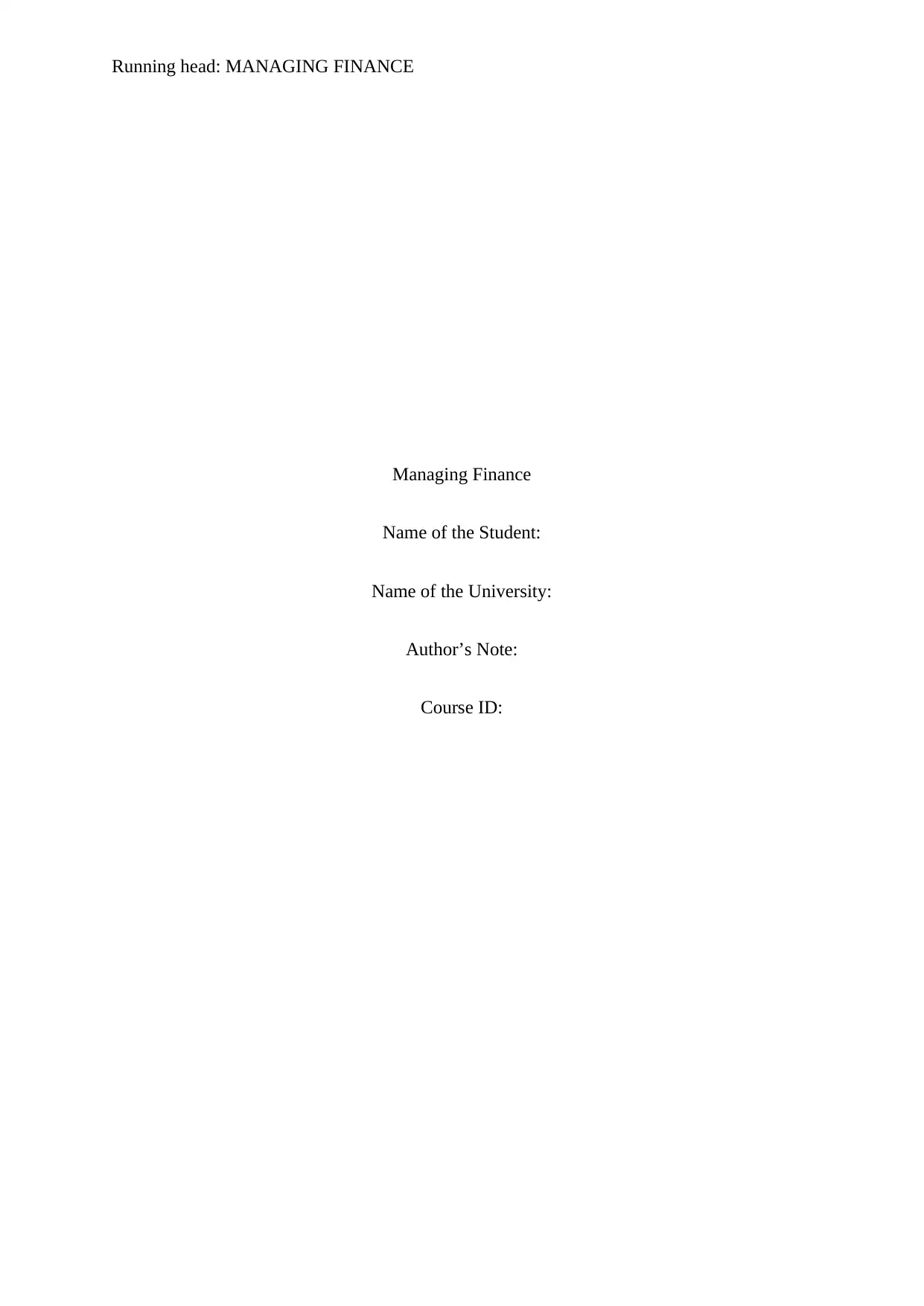
Running head: MANAGING FINANCE
Managing Finance
Name of the Student:
Name of the University:
Author’s Note:
Course ID:
Managing Finance
Name of the Student:
Name of the University:
Author’s Note:
Course ID:
Paraphrase This Document
Need a fresh take? Get an instant paraphrase of this document with our AI Paraphraser
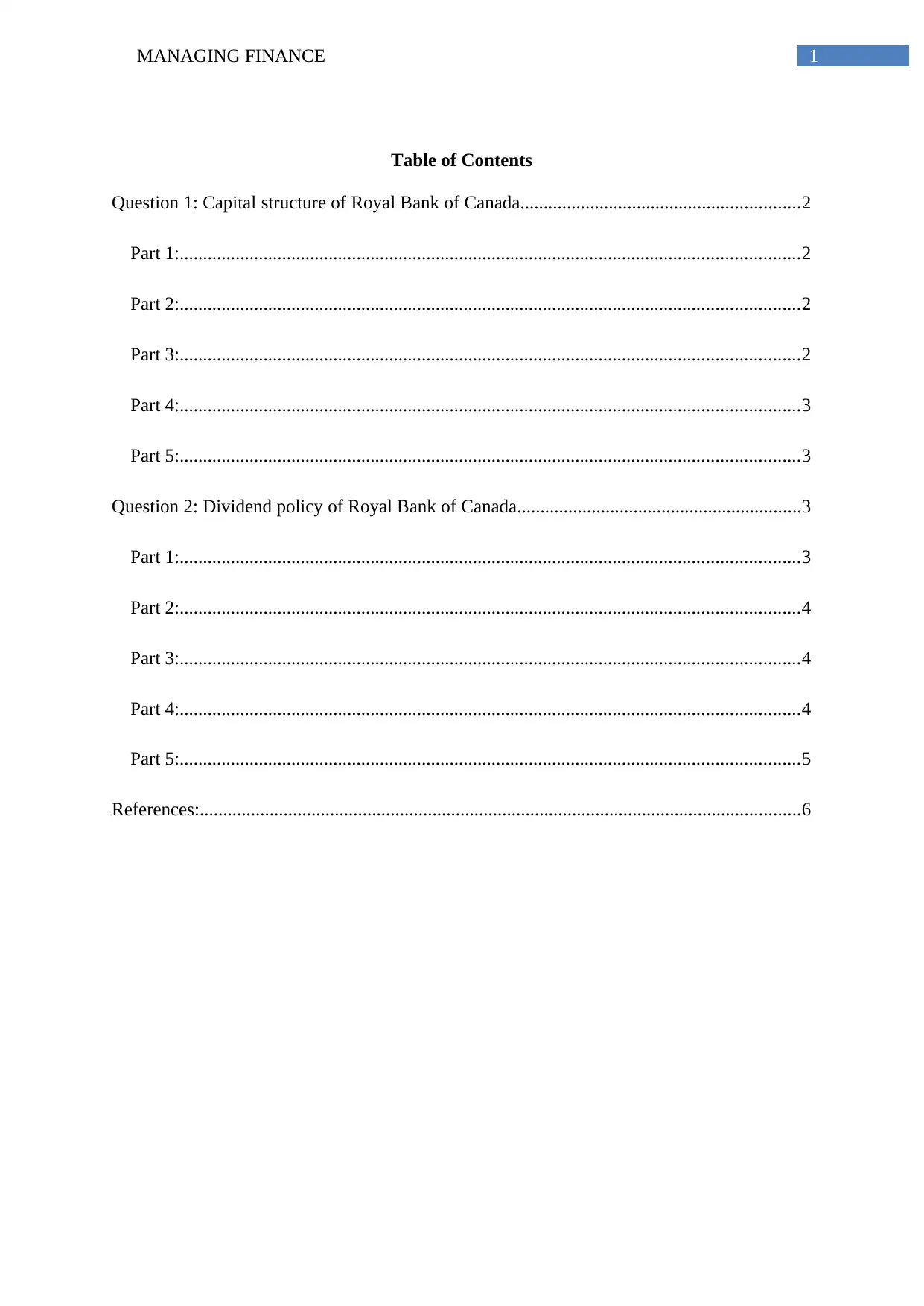
1MANAGING FINANCE
Table of Contents
Question 1: Capital structure of Royal Bank of Canada............................................................2
Part 1:.....................................................................................................................................2
Part 2:.....................................................................................................................................2
Part 3:.....................................................................................................................................2
Part 4:.....................................................................................................................................3
Part 5:.....................................................................................................................................3
Question 2: Dividend policy of Royal Bank of Canada.............................................................3
Part 1:.....................................................................................................................................3
Part 2:.....................................................................................................................................4
Part 3:.....................................................................................................................................4
Part 4:.....................................................................................................................................4
Part 5:.....................................................................................................................................5
References:.................................................................................................................................6
Table of Contents
Question 1: Capital structure of Royal Bank of Canada............................................................2
Part 1:.....................................................................................................................................2
Part 2:.....................................................................................................................................2
Part 3:.....................................................................................................................................2
Part 4:.....................................................................................................................................3
Part 5:.....................................................................................................................................3
Question 2: Dividend policy of Royal Bank of Canada.............................................................3
Part 1:.....................................................................................................................................3
Part 2:.....................................................................................................................................4
Part 3:.....................................................................................................................................4
Part 4:.....................................................................................................................................4
Part 5:.....................................................................................................................................5
References:.................................................................................................................................6
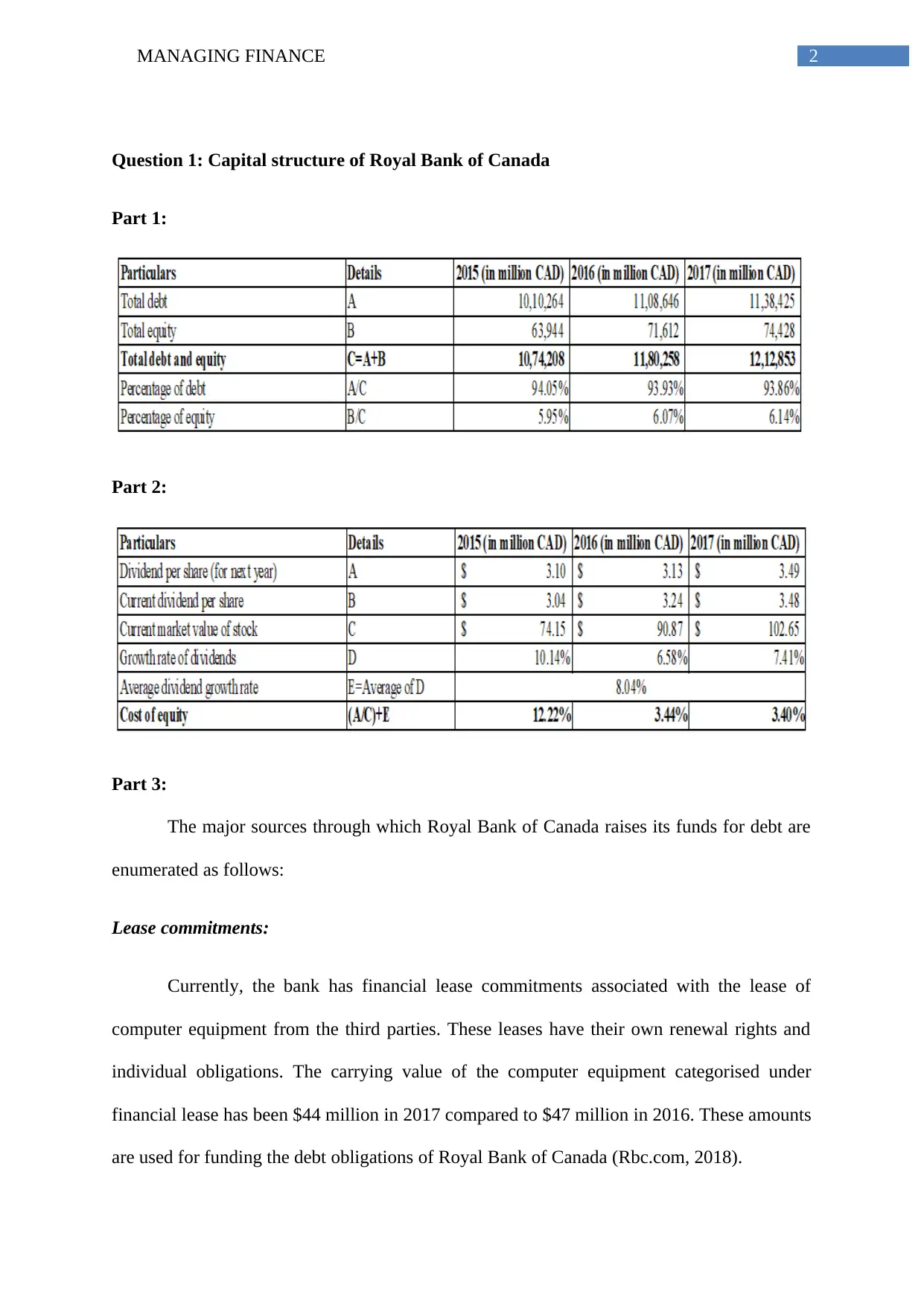
2MANAGING FINANCE
Question 1: Capital structure of Royal Bank of Canada
Part 1:
Part 2:
Part 3:
The major sources through which Royal Bank of Canada raises its funds for debt are
enumerated as follows:
Lease commitments:
Currently, the bank has financial lease commitments associated with the lease of
computer equipment from the third parties. These leases have their own renewal rights and
individual obligations. The carrying value of the computer equipment categorised under
financial lease has been $44 million in 2017 compared to $47 million in 2016. These amounts
are used for funding the debt obligations of Royal Bank of Canada (Rbc.com, 2018).
Question 1: Capital structure of Royal Bank of Canada
Part 1:
Part 2:
Part 3:
The major sources through which Royal Bank of Canada raises its funds for debt are
enumerated as follows:
Lease commitments:
Currently, the bank has financial lease commitments associated with the lease of
computer equipment from the third parties. These leases have their own renewal rights and
individual obligations. The carrying value of the computer equipment categorised under
financial lease has been $44 million in 2017 compared to $47 million in 2016. These amounts
are used for funding the debt obligations of Royal Bank of Canada (Rbc.com, 2018).
⊘ This is a preview!⊘
Do you want full access?
Subscribe today to unlock all pages.

Trusted by 1+ million students worldwide
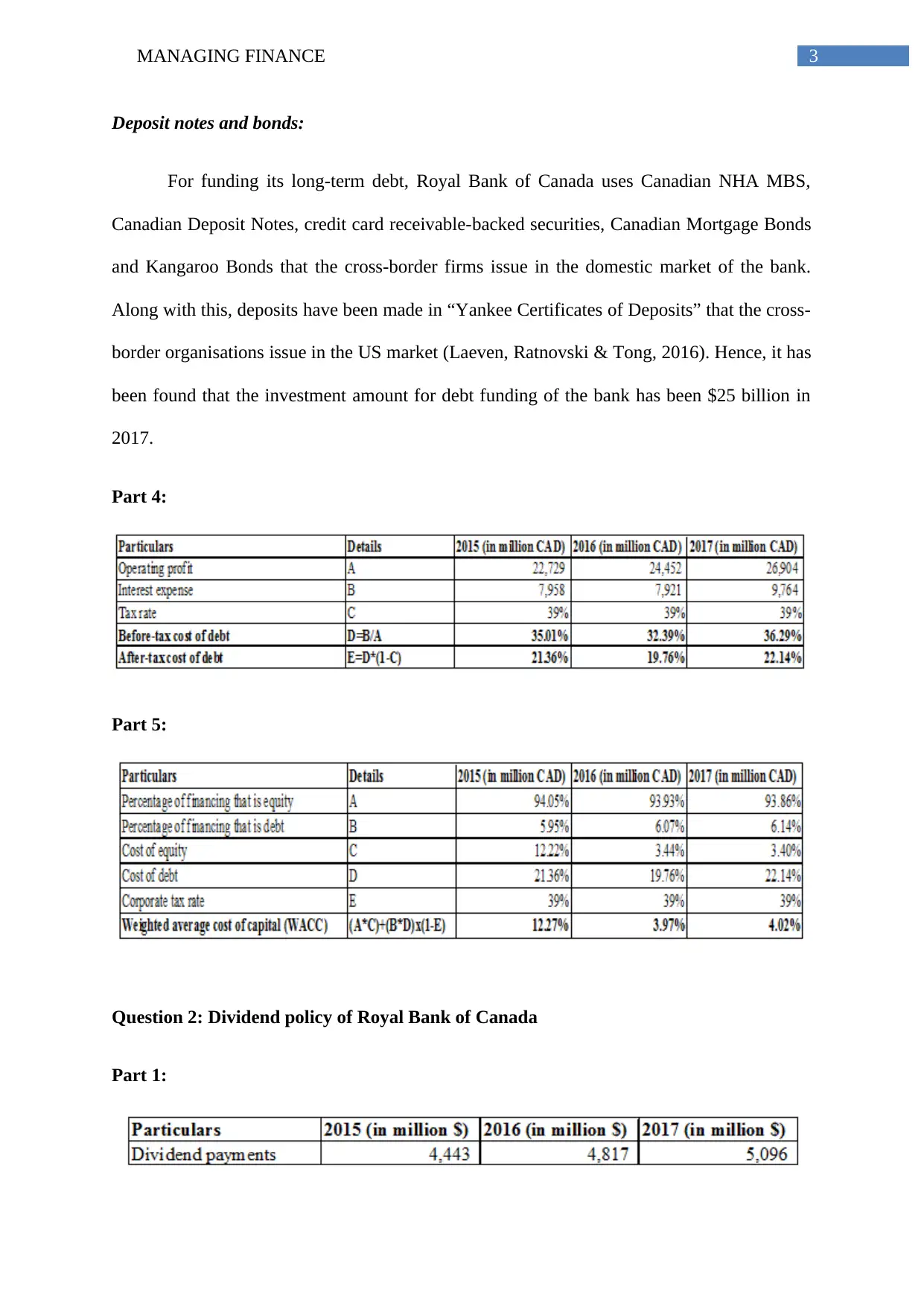
3MANAGING FINANCE
Deposit notes and bonds:
For funding its long-term debt, Royal Bank of Canada uses Canadian NHA MBS,
Canadian Deposit Notes, credit card receivable-backed securities, Canadian Mortgage Bonds
and Kangaroo Bonds that the cross-border firms issue in the domestic market of the bank.
Along with this, deposits have been made in “Yankee Certificates of Deposits” that the cross-
border organisations issue in the US market (Laeven, Ratnovski & Tong, 2016). Hence, it has
been found that the investment amount for debt funding of the bank has been $25 billion in
2017.
Part 4:
Part 5:
Question 2: Dividend policy of Royal Bank of Canada
Part 1:
Deposit notes and bonds:
For funding its long-term debt, Royal Bank of Canada uses Canadian NHA MBS,
Canadian Deposit Notes, credit card receivable-backed securities, Canadian Mortgage Bonds
and Kangaroo Bonds that the cross-border firms issue in the domestic market of the bank.
Along with this, deposits have been made in “Yankee Certificates of Deposits” that the cross-
border organisations issue in the US market (Laeven, Ratnovski & Tong, 2016). Hence, it has
been found that the investment amount for debt funding of the bank has been $25 billion in
2017.
Part 4:
Part 5:
Question 2: Dividend policy of Royal Bank of Canada
Part 1:
Paraphrase This Document
Need a fresh take? Get an instant paraphrase of this document with our AI Paraphraser
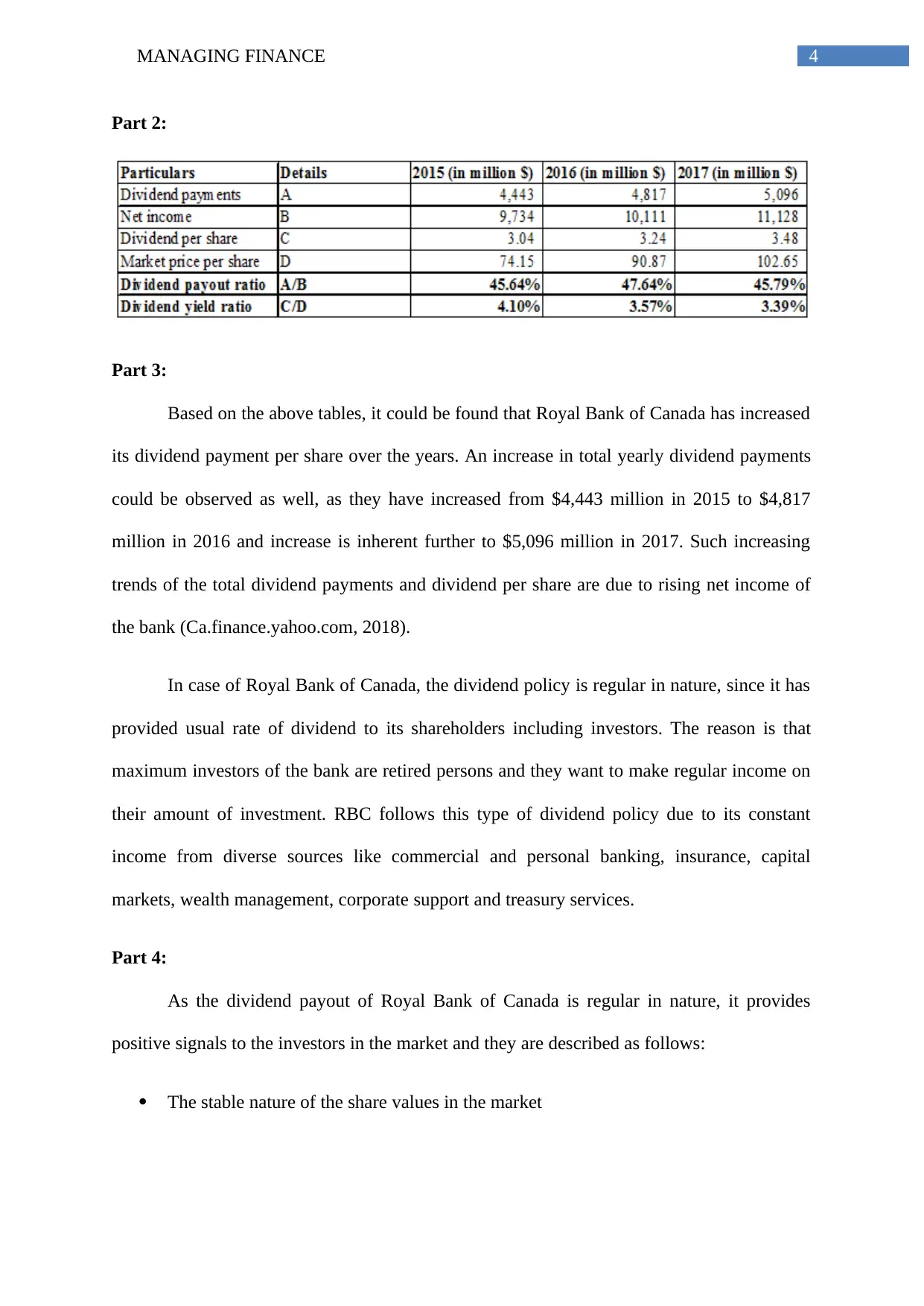
4MANAGING FINANCE
Part 2:
Part 3:
Based on the above tables, it could be found that Royal Bank of Canada has increased
its dividend payment per share over the years. An increase in total yearly dividend payments
could be observed as well, as they have increased from $4,443 million in 2015 to $4,817
million in 2016 and increase is inherent further to $5,096 million in 2017. Such increasing
trends of the total dividend payments and dividend per share are due to rising net income of
the bank (Ca.finance.yahoo.com, 2018).
In case of Royal Bank of Canada, the dividend policy is regular in nature, since it has
provided usual rate of dividend to its shareholders including investors. The reason is that
maximum investors of the bank are retired persons and they want to make regular income on
their amount of investment. RBC follows this type of dividend policy due to its constant
income from diverse sources like commercial and personal banking, insurance, capital
markets, wealth management, corporate support and treasury services.
Part 4:
As the dividend payout of Royal Bank of Canada is regular in nature, it provides
positive signals to the investors in the market and they are described as follows:
The stable nature of the share values in the market
Part 2:
Part 3:
Based on the above tables, it could be found that Royal Bank of Canada has increased
its dividend payment per share over the years. An increase in total yearly dividend payments
could be observed as well, as they have increased from $4,443 million in 2015 to $4,817
million in 2016 and increase is inherent further to $5,096 million in 2017. Such increasing
trends of the total dividend payments and dividend per share are due to rising net income of
the bank (Ca.finance.yahoo.com, 2018).
In case of Royal Bank of Canada, the dividend policy is regular in nature, since it has
provided usual rate of dividend to its shareholders including investors. The reason is that
maximum investors of the bank are retired persons and they want to make regular income on
their amount of investment. RBC follows this type of dividend policy due to its constant
income from diverse sources like commercial and personal banking, insurance, capital
markets, wealth management, corporate support and treasury services.
Part 4:
As the dividend payout of Royal Bank of Canada is regular in nature, it provides
positive signals to the investors in the market and they are described as follows:
The stable nature of the share values in the market
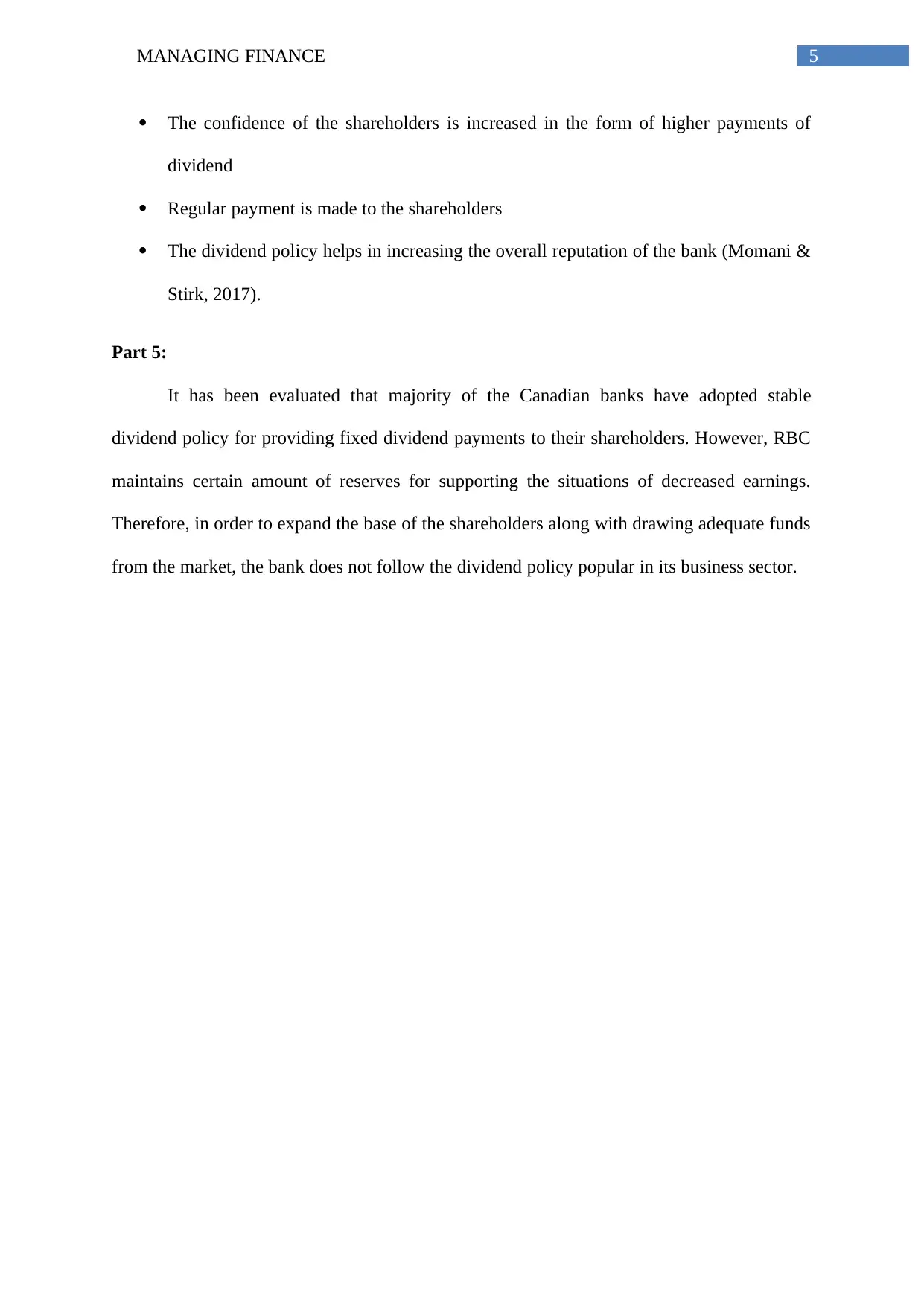
5MANAGING FINANCE
The confidence of the shareholders is increased in the form of higher payments of
dividend
Regular payment is made to the shareholders
The dividend policy helps in increasing the overall reputation of the bank (Momani &
Stirk, 2017).
Part 5:
It has been evaluated that majority of the Canadian banks have adopted stable
dividend policy for providing fixed dividend payments to their shareholders. However, RBC
maintains certain amount of reserves for supporting the situations of decreased earnings.
Therefore, in order to expand the base of the shareholders along with drawing adequate funds
from the market, the bank does not follow the dividend policy popular in its business sector.
The confidence of the shareholders is increased in the form of higher payments of
dividend
Regular payment is made to the shareholders
The dividend policy helps in increasing the overall reputation of the bank (Momani &
Stirk, 2017).
Part 5:
It has been evaluated that majority of the Canadian banks have adopted stable
dividend policy for providing fixed dividend payments to their shareholders. However, RBC
maintains certain amount of reserves for supporting the situations of decreased earnings.
Therefore, in order to expand the base of the shareholders along with drawing adequate funds
from the market, the bank does not follow the dividend policy popular in its business sector.
⊘ This is a preview!⊘
Do you want full access?
Subscribe today to unlock all pages.

Trusted by 1+ million students worldwide
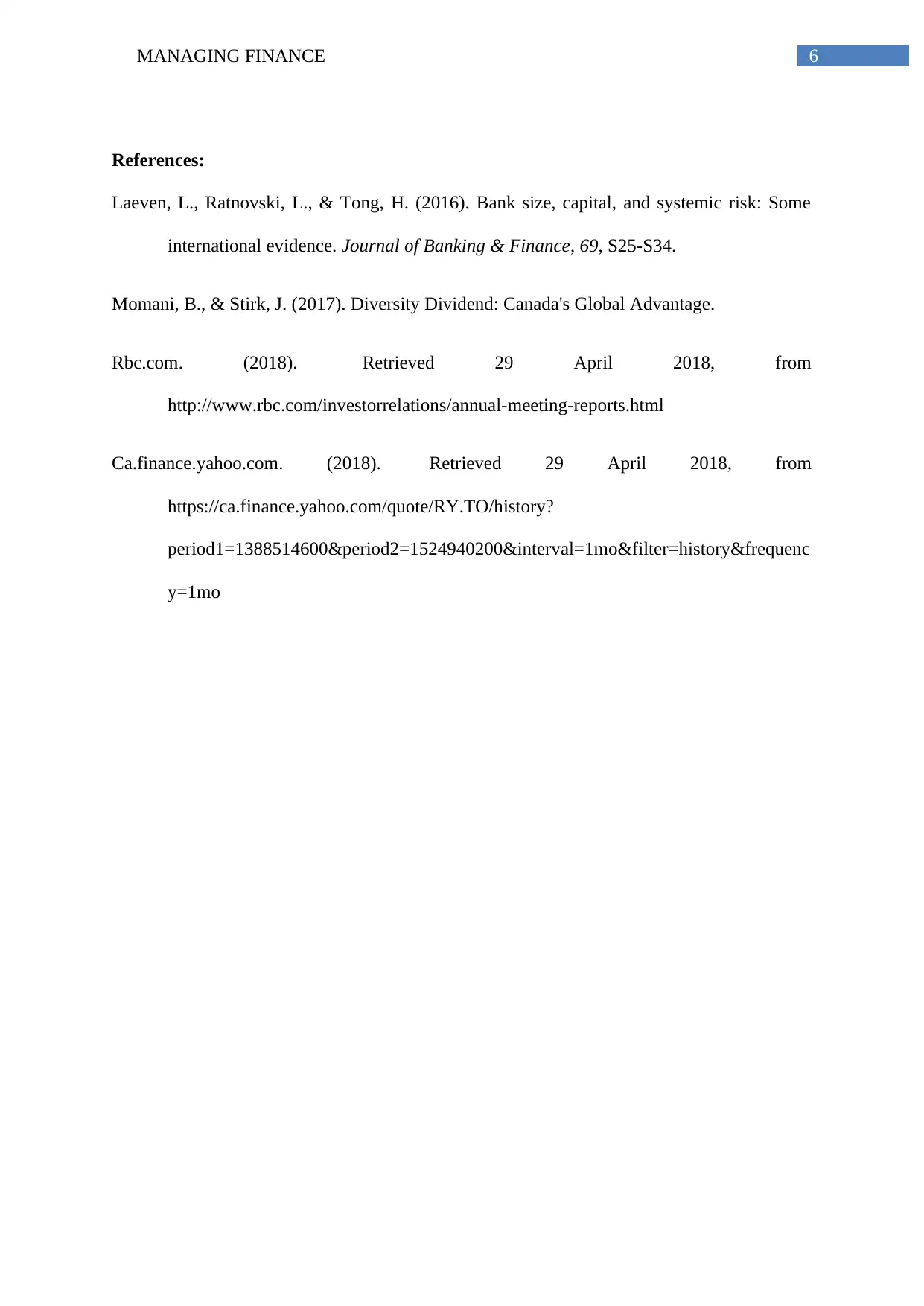
6MANAGING FINANCE
References:
Laeven, L., Ratnovski, L., & Tong, H. (2016). Bank size, capital, and systemic risk: Some
international evidence. Journal of Banking & Finance, 69, S25-S34.
Momani, B., & Stirk, J. (2017). Diversity Dividend: Canada's Global Advantage.
Rbc.com. (2018). Retrieved 29 April 2018, from
http://www.rbc.com/investorrelations/annual-meeting-reports.html
Ca.finance.yahoo.com. (2018). Retrieved 29 April 2018, from
https://ca.finance.yahoo.com/quote/RY.TO/history?
period1=1388514600&period2=1524940200&interval=1mo&filter=history&frequenc
y=1mo
References:
Laeven, L., Ratnovski, L., & Tong, H. (2016). Bank size, capital, and systemic risk: Some
international evidence. Journal of Banking & Finance, 69, S25-S34.
Momani, B., & Stirk, J. (2017). Diversity Dividend: Canada's Global Advantage.
Rbc.com. (2018). Retrieved 29 April 2018, from
http://www.rbc.com/investorrelations/annual-meeting-reports.html
Ca.finance.yahoo.com. (2018). Retrieved 29 April 2018, from
https://ca.finance.yahoo.com/quote/RY.TO/history?
period1=1388514600&period2=1524940200&interval=1mo&filter=history&frequenc
y=1mo
1 out of 7
Related Documents
Your All-in-One AI-Powered Toolkit for Academic Success.
+13062052269
info@desklib.com
Available 24*7 on WhatsApp / Email
![[object Object]](/_next/static/media/star-bottom.7253800d.svg)
Unlock your academic potential
Copyright © 2020–2025 A2Z Services. All Rights Reserved. Developed and managed by ZUCOL.




